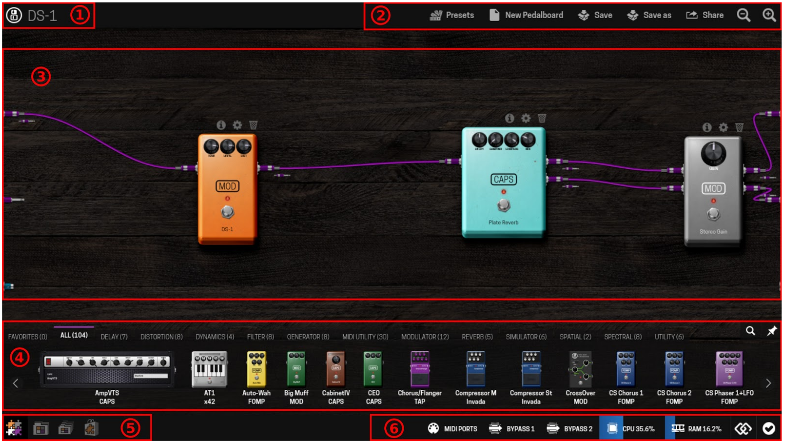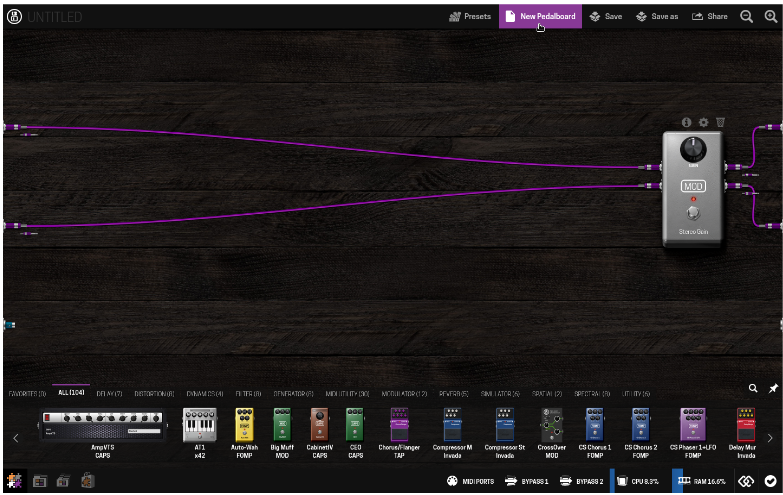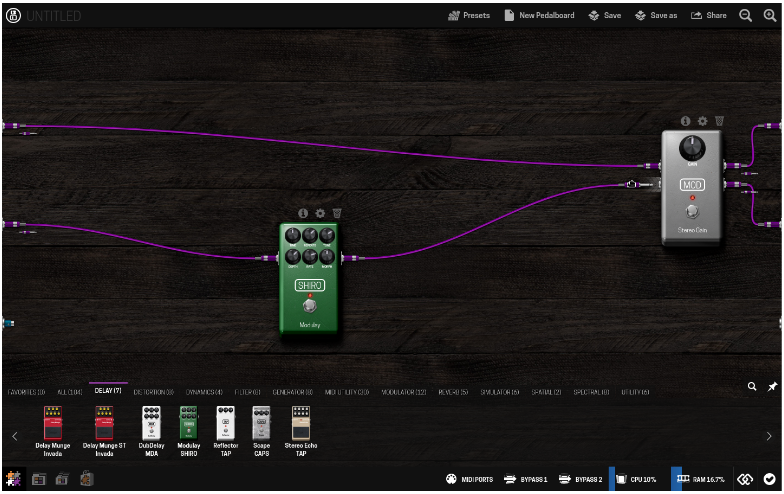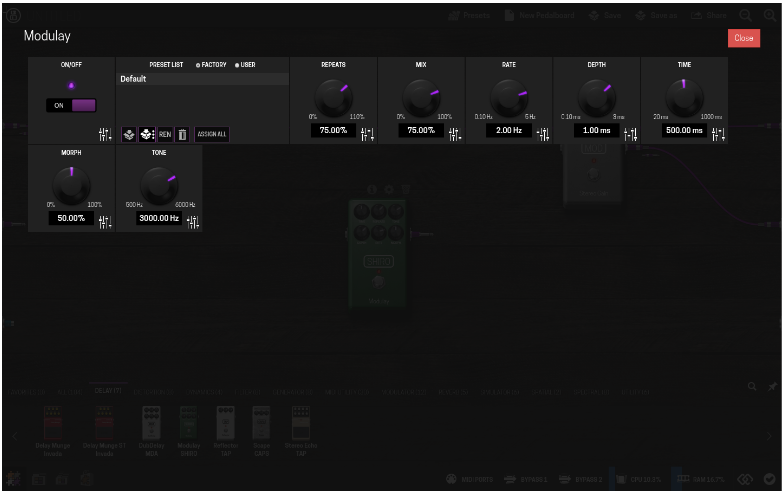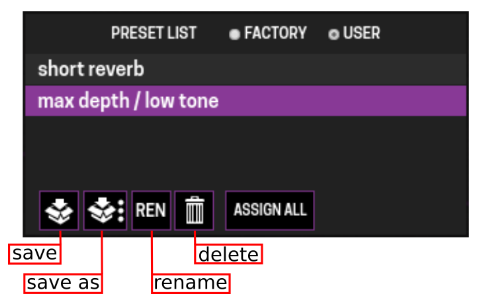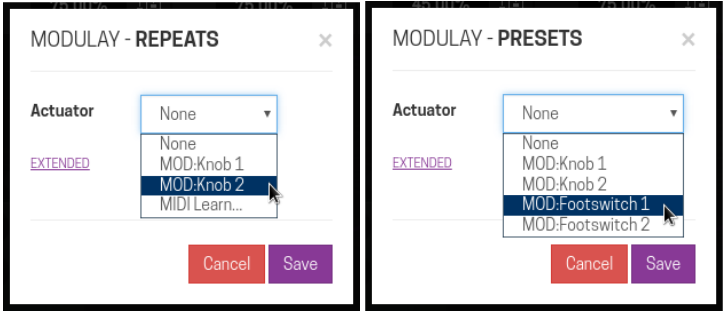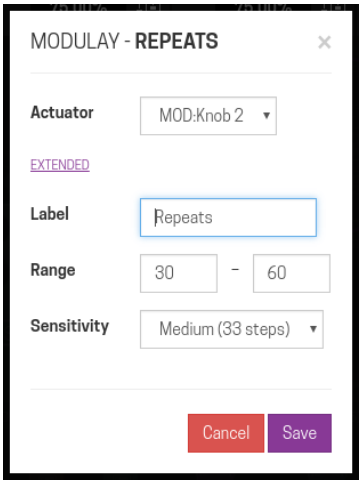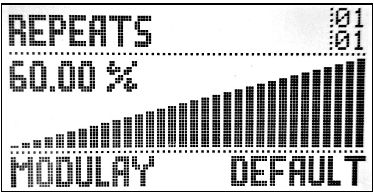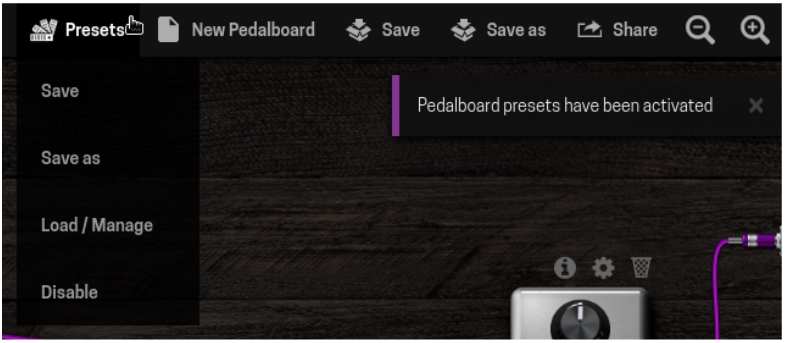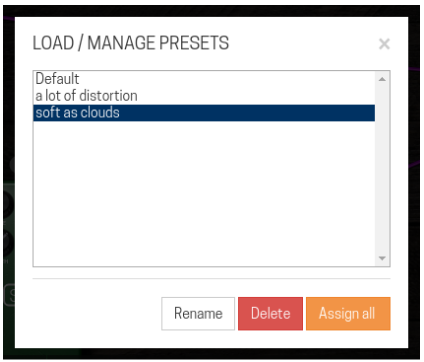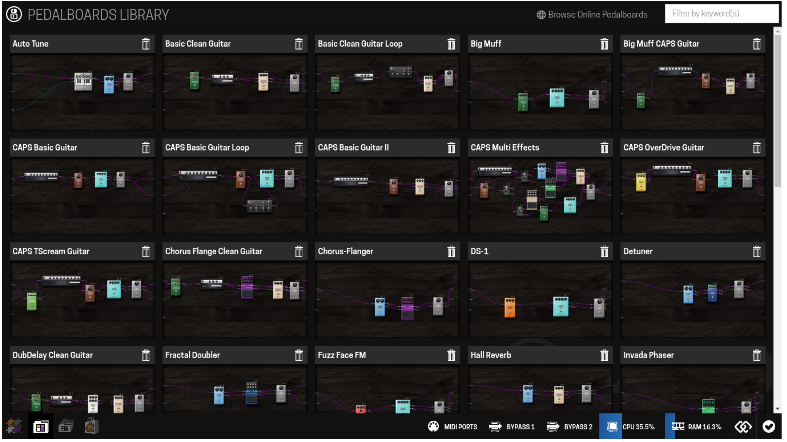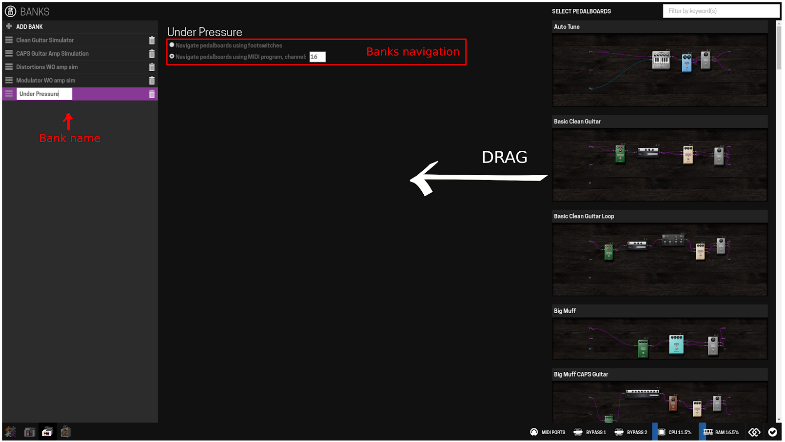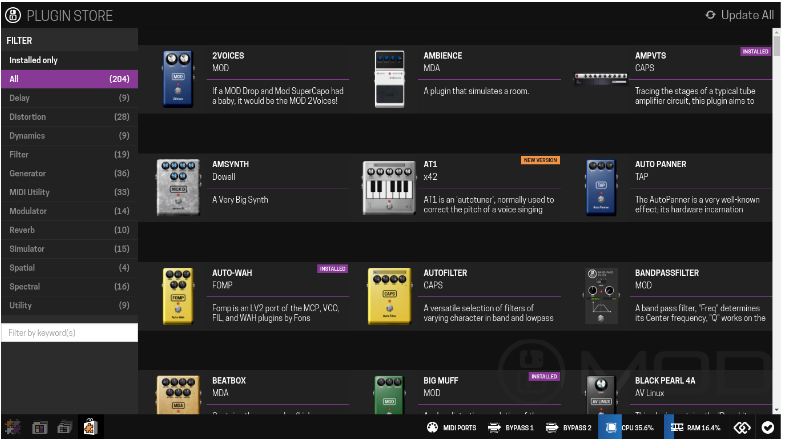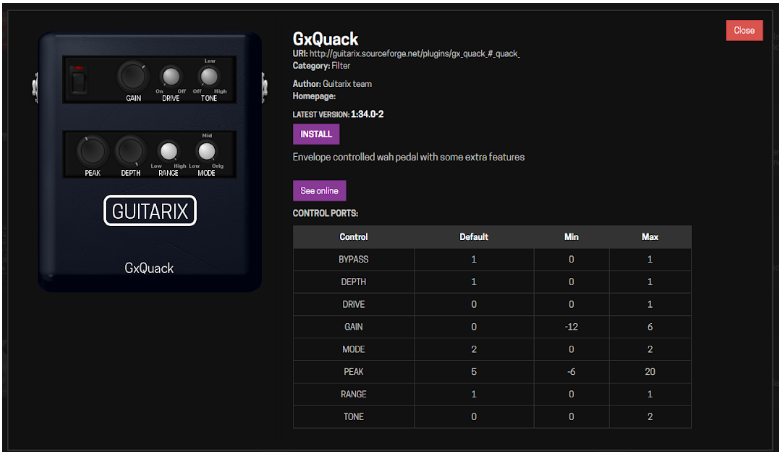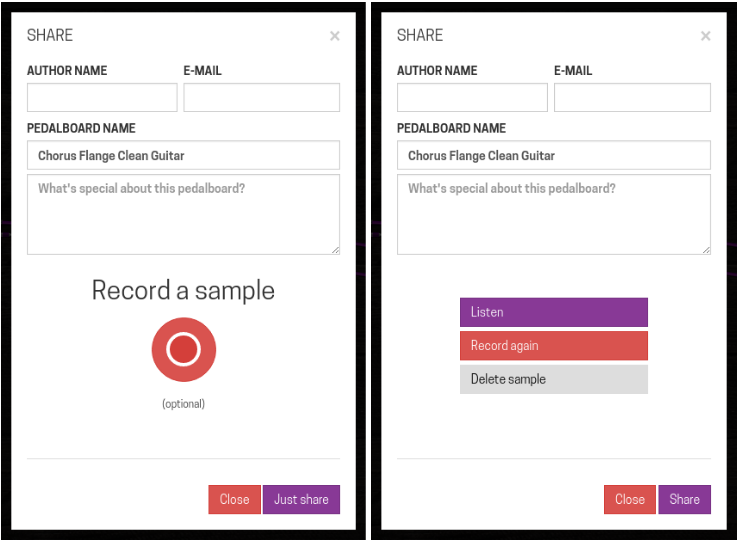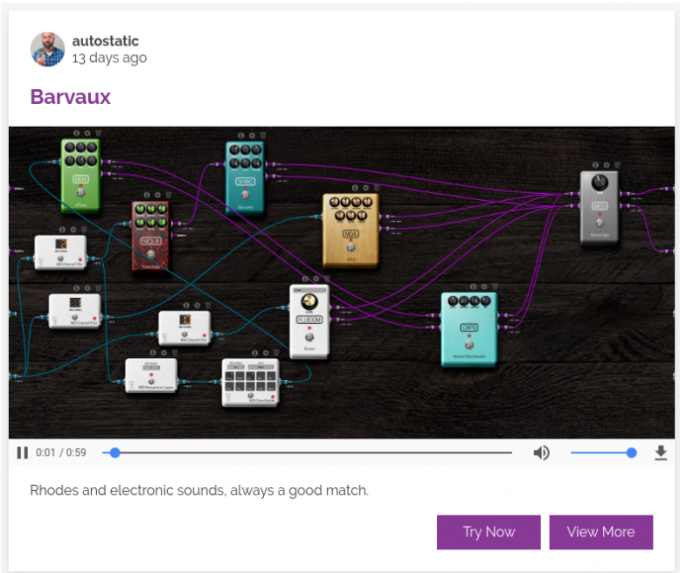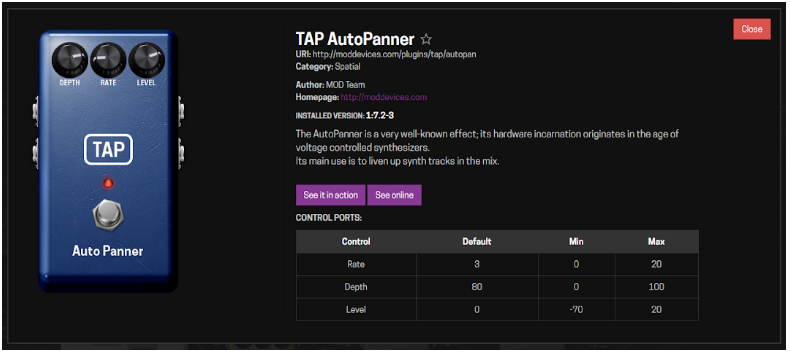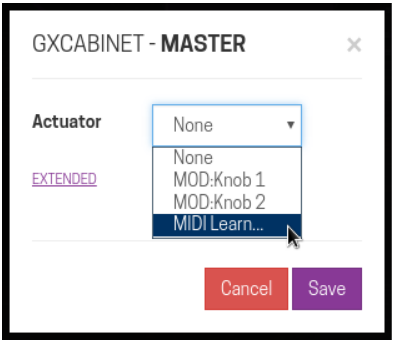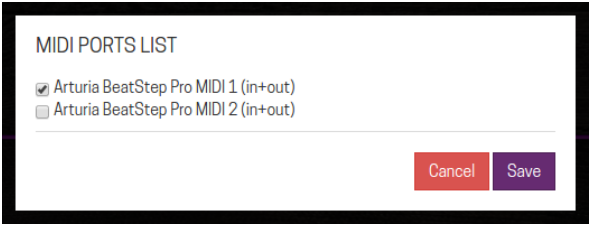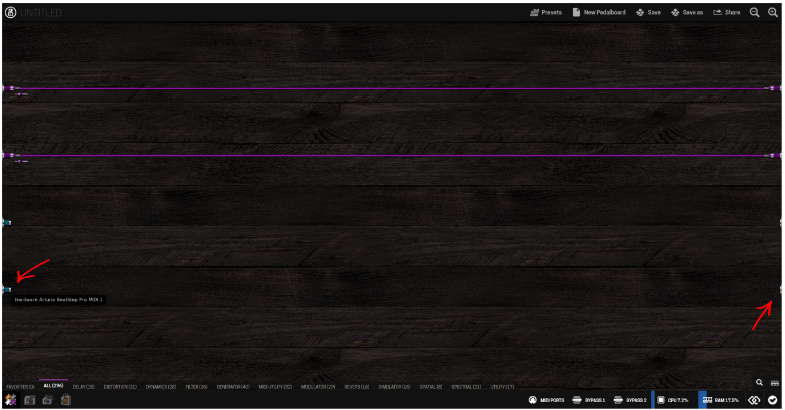MOD Web GUI User Guide
This page describes the graphical user interface (GUI) that is used for installing and removing plugins, setting up your pedalboards and banks, sharing pedalboards, updating the DUO and more.
Contents
- 1 Accessing the GUI
- 2 Creating a pedalboard
- 3 Expanding Controls
- 4 CPU Usage
Accessing the GUI
Connect the MOD Duo to your PC or Mac using the USB cable which you received with your MOD Duo. The operating system should recognize the MOD Duo as a network device and configure it automatically. However, this process may fail in certain Windows versions, if that is your case please check the troubleshooting page.
Then open your favorite browser and navigate to http://modduo.local or http://192.168.51.1.
Creating a pedalboard
Once you have accessed the GUI you should see a screen like this:
The numbered areas on the interface are:
- Pedalboard name
- Pedalboard actions bar
- Pedalboard assembler
- Plugins bar
- Mode selector (Assembler, Pedalboards, Banks and Store)
- Status bar (Device actions and information)
On the left edge of the assembler area there are 3 connectors: 2 audio inputs and 1 MIDI input. On the right edge there are another 3 connectors: 2 audio outputs and 1 MIDI output. All those connectors represent the real inputs and outputs of your MOD Duo. Be aware that on the interface the signal flows from left to right.
- Purple cables transport audio signals
- Cyan cables transport MIDI signals
- Orange cables transport CV signals.
New pedalboard
To create a new pedalboard click on the ![]() button in the pedalboard actions bar. This action will load the default pedalboard, which is a stereo gain connecting the audio inputs to the outputs.
button in the pedalboard actions bar. This action will load the default pedalboard, which is a stereo gain connecting the audio inputs to the outputs.
Adding and connecting plugins
To add plugins, drag-and-drop one from the plugins bar to the pedalboard assembler area. To make a new connection, click on the plugin’s output jack and drag it to where you want to connect it to. To unmake a connection, click on the connected jack, then drag and release it to any empty area on the assembler.
Note that the inputs and outputs of the MOD Duo are completely independent and can process multiple audio paths. The MOD Duo allows you to create multiple connections coming out from the same output and also allows multiple connections to come in the same input. This feature allows the user to create complex pedalboards.
Adjusting plugins parameters
Each plugin has 3 icons on its top: info ![]() , settings
, settings ![]() and delete
and delete ![]() . To adjust the parameters of the plugin click on the settings icon.
. To adjust the parameters of the plugin click on the settings icon.
Each knob, list and switch represents a parameter of the plugin and can be adjusted as desired. The combination of all parameter values can be saved/loaded as a user preset and, for the cases in which they are available, factory presets can be loaded.
Assigning plugins parameters to actuators
One of the most powerful features that the MOD Duo offers is the ability to assign plugin parameters and preset lists to physical actuators, like knobs and footswitches.
To create an assignment, first click on the fader icon ![]() , found on the bottom-right corner of each parameter box, to open the assignment dialog box. Afterwards, select the actuator you would like to assign the parameter to from the dropdown list. The knobs can hold multiple assignments but footswitches can only hold one.
, found on the bottom-right corner of each parameter box, to open the assignment dialog box. Afterwards, select the actuator you would like to assign the parameter to from the dropdown list. The knobs can hold multiple assignments but footswitches can only hold one.
Any parameter can be assigned, but some parameters can only be assigned to a specific type of actuator. The interface will not show the actuator as an option if it is not allowed to be assigned to. Note that preset lists can also be assigned to actuators.
This table shows which parameter type can be assigned to each actuator.
| Footswitch | Knob | MIDI Learn | |
|---|---|---|---|
| Bypass/Toggle | Yes | No | Yes |
| Trigger | Yes | No | Yes |
| List | Yes | Yes | Lists with 2 values |
| Value | Tap Tempo parameters | Yes | Yes |
There is also the possibility to adjust further options by clicking on the EXTENDED label.
Here you can:
- Enter the label that you would like to be displayed on the displays of the MOD Duo
- Enter the range that you want the mapped actuator to sweep within, inverted ranges are also possible by setting the first parameter higher than the second parameter
- Set the sensitivity (amount of steps from minimum to maximum) of the actuator from the dropdown menu
Once you have done the adjustments, click on the save button to execute the assignment. At this point you should see the assigned information on the display and be able to operate the parameter through the actuator you have chosen.
Assigning plugins parameters to Control Chain actuators
You can assign plugin parameters and preset lists to Control Chain actuators in the same way as the regular actuators on the MOD Duo. See Control Chain
Saving / loading pedalboard presets
You have the possibility to save the combination of parameter adjustments as a pedalboard preset. In order to do so, turn on the pedalboard presets mode by clicking on the presets button ![]() , positioned on the pedalboard actions bar.
, positioned on the pedalboard actions bar.
To save the changes to the current pedalboard preset, choose the option Save. To save a new preset use the option Save as and give it a name. To load, delete or rename a saved preset use the option Load / Manage.
A single click on the name of the preset will load it. You also have the option to assign the presets list to an actuator by using the Assign all button.
Saving a pedalboard
To save a pedalboard use the buttons Save or Save as on the pedalboard actions bar. All previously saved pedalboards can be found and loaded from the pedalboards library. To access the pedalboards library click on its button ![]() in the mode selection bar.
in the mode selection bar.
A single click on the pedalboard image or name will load it to the assembler. To delete a pedalboard click on its trash icon ![]() on the right of the pedalboard name.
on the right of the pedalboard name.
Organizing Banks
In order to make it easy to access your pedalboards while the MOD Duo is disconnected from your PC, Mac or tablet, you can organize your pedalboards in banks. To access the banks configuration click on the banks icon ![]() in the mode selection bar.
in the mode selection bar.
In the banks configuration mode, use the ![]() button to create a new bank and name it as you like. At this point your bank is empty and ready to receive your pedalboards. To add pedalboards to your bank drag them from the right lateral panel into the center of the screen. You can add as many pedalboards as you want. It is also possible to add multiple instances of the same pedalboard to your bank.
button to create a new bank and name it as you like. At this point your bank is empty and ready to receive your pedalboards. To add pedalboards to your bank drag them from the right lateral panel into the center of the screen. You can add as many pedalboards as you want. It is also possible to add multiple instances of the same pedalboard to your bank.
In the top-center of the screen, under the bank name, you can choose how you want to navigate between the pedalboards of this bank when the MOD Duo is not connected to the PC, Mac or tablet. There are two options: using the MOD Duo footswitches or using MIDI program change messages.
Installing new plugins
By default the MOD Duo comes with many plugins installed, but you can install even more. The plugins available for download on the MOD Duo are created either by the MOD team, or by independent developers. To learn more about plugins please check the Advanced Information chapter.
In order to install new plugins you need to access the plugin store by clicking on its icon ![]() in the mode selection bar. After you have accessed the store you can look for the plugin you want by filtering by category or typing a keyword in the search box.
in the mode selection bar. After you have accessed the store you can look for the plugin you want by filtering by category or typing a keyword in the search box.
Once you have decided which plugin you want to install, click on it to open the description dialog, and then click on the install button. The plugin will be automatically downloaded and installed on your MOD Duo. You can also remove or upgrade an already installed plugin by clicking on the corresponding button.
Sharing a pedalboard
Another great feature that the MOD Duo has is allowing you to share and load pedalboards from the existing MOD online community. To share a pedalboard, go to the pedalboard assembler and click on the share ![]() button in the pedalboard actions bar. Fill in the sharing dialog and (optionally) record a sample by clicking on the red circle. After finishing the recording, you can listen to it, or record it again. When you are done, click on the Share button.
button in the pedalboard actions bar. Fill in the sharing dialog and (optionally) record a sample by clicking on the red circle. After finishing the recording, you can listen to it, or record it again. When you are done, click on the Share button.
To load pedalboards from another MOD Duo user, visit: https://pedalboards.moddevices.com, listen to the samples and once you find a pedalboard you like, click on the Try Now button. Note that in order to load an online pedalboard, you need to have the MOD GUI opened.
Use the View More button to see what plugins were used to create the pedalboard. Additionally you can list the pedalboards that were made using a specific plugin. In order to do this, open the plugin description dialog (for example by clicking on the
![]() info button on the top of the plugin), and then click on the See it in action button.
info button on the top of the plugin), and then click on the See it in action button.
Expanding Controls
MIDI devices
There are two ways to connect MIDI devices, via the classic MIDI DIN connector and via USB.
MIDI DIN - Input
To use the MIDI DIN simply connect your device to the MIDI Input and use the MIDI Learn function to assign a control to a plugin parameter (see #Assigning plugins parameters to actuators).
Once you selected and saved the MIDI Learn function go to your MIDI device and operate the actuator you want to control the parameter. At this point you should be able to control the plugin parameter using your MIDI device.
MIDI DIN - Output
Some plugins have MIDI output ports, which generate MIDI output data like control change messages and notes. You can use this output to send this data to your other equipment.
MIDI USB
In addition to the classic MIDI ports you can also use the USB port to connect your MIDI device. The MOD Duo will recognize your MIDI device when it is plugged in and add it to the MIDI ports list. Because a single MIDI device can have multiple ports, they are not visible in the assembler by default. To make them visible you will have to enable them first by clicking on the MIDI ports ![]() button.
button.
On the MIDI ports list select the ports that you want to enable and click on the Save button. Now you should see the new ports added to the assembler screen.
Note that you do not have to enable a specific MIDI port to be able to use MIDI learn. For MIDI learn, all MIDI devices will work as soon as they are connected to the MOD Duo.
CPU Usage
In the status bar of the GUI there are CPU and RAM meters. It is useful to monitor these resources when you are creating your pedalboard. It’s recommended to keep the CPU usage lower than 80%. Note that each plugin consumes a different amount of CPU and RAM.
